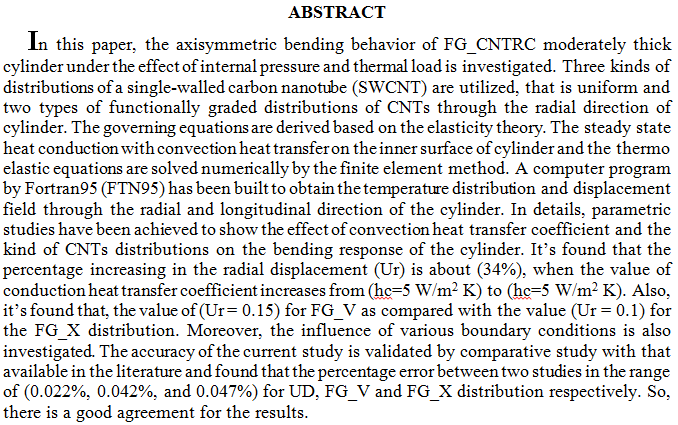
This paper focuses on Load distribution factors for horizontally curved composite concrete-steel girder bridges. The finite-element analysis software“SAP2000” is used to examine the key parameters that can influence the distribution factors for horizontally curved composite steel
girders. A parametric study is conducted to study the load distribution characteristics of such bridge system due to dead loading and AASHTO truck loading using finite elements method. The key parameters considered in this study are: span-to-radius of curvature ratio, span length, number of girders, girders spacing, number of lanes, and truck loading conditions. The results have shown that the curvature is the most critical factor which plays an important
Background: Glass ionomers have good biocompatibility and the ability to adhere to both enamel and dentin. However, they have certain demerits, mainly low tensile and compressive strengths. Therefore, this study was done to assess consistency and compressive strength of glass ionomer reinforced by different amount of hydroxyapatite. Materials and Methods: In this study hydroxyapatite materials were added to glass ionomer cement at different ratios, 10%, 15%, 20%, 25% and 30% (by weight). The standard consistency test described in America dental association (ADA) specification No. 8 was used, so that all new base materials could be conveniently mixed and the results would be of comparable value and the compressive strength test described by
... Show More (10)
(10)
 (6)
(6)
تقدم هذه الدراسة وصفا للطريقة المستخدمة في تحضير الكربون المنشط (AC)من بقايا الشاي. تم دراسة الخواص الفيزيائية والكيميائية وكفاءة الامتزاز للكربون المنشط المحضر. تم إنتاج الكربون المنشط (AC) على مرحلتين: الاولى التنشيط باستخدام حامض الفوسفوريك (H3PO4) والثانية الكربنة عند درجة حرارة 450 درجة مئوية. استخدم الكربون المنشط لغرض امتصاص العقار الدوائي السيبروفلوكساسين(CIP) . تمت دراسة عدة عوامل تشغيلية بدرجة حرار
... Show Moreتقدم هذه الدراسة وصفا للطريقة المستخدمة في تحضير الكربون المنشط (AC)من بقايا الشاي. تم دراسة الخواص الفيزيائية والكيميائية وكفاءة الامتزاز للكربون المنشط المحضر. تم إنتاج الكربون المنشط (AC) على مرحلتين: الاولى التنشيط باستخدام حامض الفوسفوريك (H3PO4) والثانية الكربنة عند درجة حرارة 450 درجة مئوية. استخدم الكربون المنشط لغرض امتصاص العقار الدوائي السيبروفلوكساسين(CIP) . تمت دراسة عدة عوامل تشغيلية بدرجة حرار
... Show More (2)
(2)
Moisture induced damage in asphaltic pavement might be considered as a serious defect that contributed to growth other distresses such as permanent deformation and fatigue cracking. This paper work aimed through an experimental effort to assess the behaviour of asphaltic mixtures that fabricated by incorporating several dosages of carbon fiber in regard to the resistance potential of harmful effect of moisture in pavement. Laboratory tests were performed on specimens containing fiber with different lengths and contents. These tests are: Marshall Test, the indirect tensile test and the index of retained strength. The optimum asphalt contents were determined based on the Marshall method. The preparation of asphaltic mixtures involved
... Show More (24)
(24)
 (18)
(18)
In this study, sawdust as a cheap method and abundant raw material was utilized to produce active carbon (SDAC). Physiochemical activation was utilized where potassium hydroxide used as a chemical activating agent and carbon dioxide was used as a physical activating agent. Taguchi method of experimental design was used to find the optimum conditions of SDAC production. The produced SDAC was characterized using SEM to investigate surface morphology and BET to estimate the specific surface area. SDAC was used in aqueous lead ions adsorption. Adsorption process was modeled statistically and represented by an empirical model. The highest specific surface area of SDAC was 688.3 m2/gm. Langmuir and Freundlich isotherms were used to
... Show More (1)
(1)
 (1)
(1)
The removal of COD from wastewater generated by petroleum refinery has been investigated by adopting electrocoagulation (EC) combined with adsorption using activated carbon (AC) derived from avocado seeds. The process variables influencing COD removal were studied: current density (2–10 mA/cm2), pH (4–9), and AC dosage (0.2–1 g/L). Response surface methodology (RSM) based on Box–Behnken design (BBD) was used to construct a mathematical model of the EC/AC process. Results showed that current density has the major effect on the COD removal with a percent of contribution 32.78% followed by pH while AC dosage has not a remarkable effect due to the good characteristics of AC derived from avocado seeds. Increasing current density gives be
... Show More (1)
(1)
